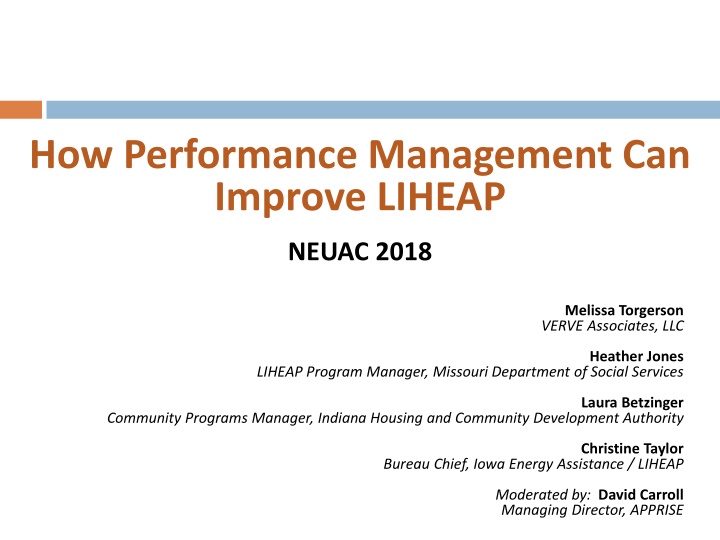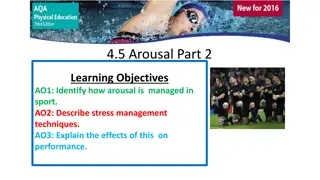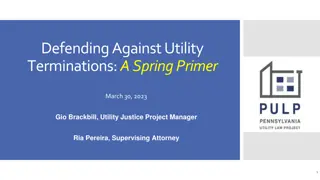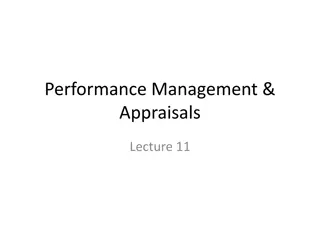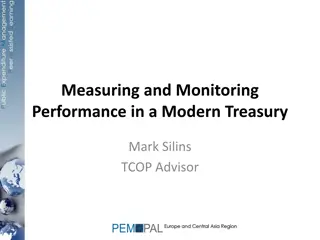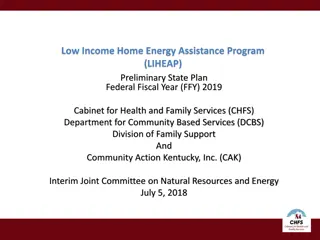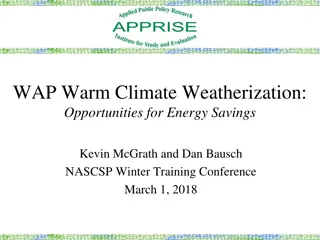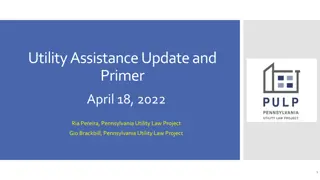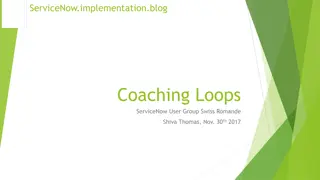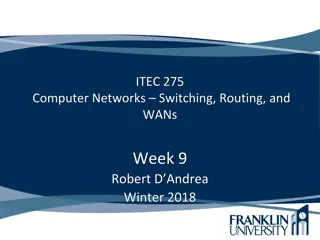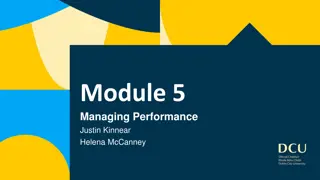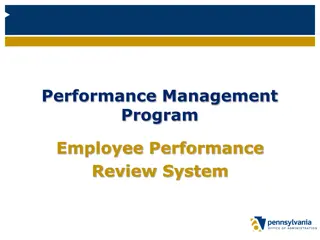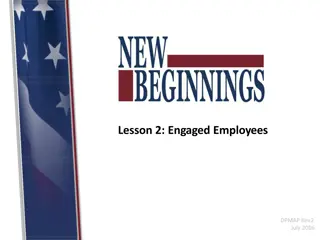Enhancing LIHEAP Performance through Performance Management
Explore how Performance Management can optimize the Low Income Home Energy Assistance Program (LIHEAP) by utilizing data analysis, program evaluation, and effective planning. Discover tools, resources, and measures to assess the impact of LIHEAP on households and improve overall program effectiveness.
Download Presentation

Please find below an Image/Link to download the presentation.
The content on the website is provided AS IS for your information and personal use only. It may not be sold, licensed, or shared on other websites without obtaining consent from the author.If you encounter any issues during the download, it is possible that the publisher has removed the file from their server.
You are allowed to download the files provided on this website for personal or commercial use, subject to the condition that they are used lawfully. All files are the property of their respective owners.
The content on the website is provided AS IS for your information and personal use only. It may not be sold, licensed, or shared on other websites without obtaining consent from the author.
E N D
Presentation Transcript
How Performance Management Can Improve LIHEAP NEUAC 2018 Melissa Torgerson VERVE Associates, LLC Heather Jones LIHEAP Program Manager, Missouri Department of Social Services Laura Betzinger Community Programs Manager, Indiana Housing and Community Development Authority Christine Taylor Bureau Chief, Iowa Energy Assistance / LIHEAP Moderated by: David Carroll Managing Director, APPRISE
How Performance Management Can Improve LIHEAP Performance Management Overview 2 PERFORMANCE MANAGEMENT is the process of evaluating data (together with other information) to make educated program decisions. Performance Management is a cycle of continuous learning and improvement over time. Presenter: Melissa Torgerson
How Performance Management Can Improve LIHEAP Performance Management Toolbox 3 For many years, LIHEAP Grantees have had a suite of data and information available to inform program evaluation and planning. Required LIHEAP Reports LIHEAP Model Plan LIHEAP Household Report LIHEAP Performance Data Form - Section I. Grantee Survey Other Data Sources LIHEAP Home Energy Notebook American Community Survey (Census) Residential Energy Consumption Survey (RECS) Presenter: Melissa Torgerson
How Performance Management Can Improve LIHEAP Performance Management Toolbox 4 New Performance Measure data provides LIHEAP grantees with important additions to their suite of Performance Management tools. Household characteristics to inform program planning Average annual income by household fuel type Average annual energy costs by household fuel type Indicators to evaluate impact of LIHEAP on households Average pre-LIHEAP Energy Burden by fuel type Average post-LIHEAP Energy Burden by fuel type Average energy burden reduction as a result of LIHEAP by fuel type Instances of Home Energy Loss Prevention v. Restoration of Home Energy Service Targeting Indices to evaluate effectiveness of program (compliance with statute) Benefit Targeting Index Burden Reduction Targeting Index Presenter: Melissa Torgerson
How Performance Management Can Improve LIHEAP Performance Management Toolbox 5 LIHEAP Performance Management Website: https://liheappm.acf.hhs.gov/ Kiosk at 2018 NEUAC conference! Guided search and ad hoc reporting tools LIHEAP Performance Management resources Presenter: Melissa Torgerson
How Performance Management Can Improve LIHEAP Performance Management Toolbox 6 For questions or more information: Melissa Torgerson Melissa@verveassociates.net 503-706-2647 Kevin McGrath Kevin-McGrath@appriseinc.org 609-252-2081 Dan Bausch Daniel-Bausch@appriseinc.org 609-252-9050 Presenter: Melissa Torgerson
How Performance Management Can Improve LIHEAP 7 Understanding LIHEAP Performance Measures Presenter: Heather Jones
How Performance Management Can Improve LIHEAP Understanding LIHEAP Performance Measures 8 Missouri State Snapshot (Executive Summary Energy Burden Measures) Does LIHEAP furnish higher benefits to higher burden households? No. In Missouri, the total LIHEAP benefit received by high burden households in FY 2017 was about $26 (8.4%) lessthan the total LIHEAP benefit received by the average recipient household. Does LIHEAP pay a larger share of the home energy bill for high burden households? No. In FY 2017, LIHEAP paid 45.3%of the energy bill for average households in Missouri, while LIHEAP paid 28.2%of the energy bill for high burden households.
How Performance Management Can Improve LIHEAP Understanding LIHEAP Performance Measures 9 MISSOURI State Snapshot (Executive Summary Prevention and Restoration Measures) Prevention of Home Energy Loss In FY 2017, LIHEAP benefits in Missouri prevented the loss of service 85,294 times, by stopping threatened utility service disconnections and by delivering fuels to homes that were at risk of running out. The program also repaired or replaced heating or cooling equipment at imminent risk of failure for 65 households. Restoration of Home Energy Service In FY 2017, LIHEAP benefits restored home energy service 15,794 times for households who had been disconnected by their utility provider or who had run out of fuel oil, propane, or wood. The program also restored home energy service for 90 households by repairing or replacing inoperable heating or cooling equipment.
How Performance Management Can Improve LIHEAP Understanding LIHEAP Performance Measures 10 MISSOURI State Snapshot Annual Income High burden householdshave an average annual income that is $7,522 or 61% less than average households. Annual Energy Bill High burden households have an average energy bill that is $291 or 41% greater than average households. Presenter: Heather Jones
How Performance Management Can Improve LIHEAP Understanding LIHEAP Performance Measures 11 MISSOURI State Snapshot Energy Burden before LIHEAP Before LIHEAP, high burden households are paying 3.6 times as much of their income toward energy costs than average households. Annual LIHEAP Benefit High burden households receive an average annual LIHEAP benefit that is $26 or 8.3% less than average households.
How Performance Measures Can Improve LIHEAP Understanding LIHEAP Performance Measures 12 MISSOURI State Snapshot Energy Burden after LIHEAP After LIHEAP, high burden households are paying 4.6 times as much of their income toward energy costs than average households. Percentage of Bill Paid On average, high burden households have 35% less of their energy bill paid with LIHEAP than average households.
How Performance Management Can Improve LIHEAP Understanding LIHEAP Performance Measures 13 MISSOURI State Snapshot Does LIHEAP furnish higher benefits to higher burden households across all fuel types? No. In FY 2017, high burden natural gas households received $11 (4%) greater benefits than average natural gas households. Similarly, high burden propane households received $58 (17%) greater benefits than average propane households. However, electric high burden households received $71 (22%) less than average electric households.
How Performance Management Can Improve LIHEAP Understanding LIHEAP Performance Measures 14 MISSOURI State Snapshot Does LIHEAP pay more of the energy bill for high burden households across all fuel types? No. In FY 2017, high burden households in Missouri had less of their energy bill paid with LIHEAP than average households, regardless of fuel type. However, the extent of this difference varies by fuel type. For example, there is a 52% difference in the share of bill paid between electric high burden and average households. However, this difference is only 11% between natural gas high burden and average households.
How Performance Management Can Improve LIHEAP Understanding LIHEAP Performance Measures 15 MISSOURI State Snapshot Are patterns of LIHEAP prevention and restoration of home energy service loss (as a result of bill payment assistance) consistent across all fuel types? In FY 2017, Missouri LIHEAP bill payment assistance resulted in higher rates of prevention (relative to restoration) across all fuel types. However, the data shows a higher proportion of restoration (relative to prevention) for natural gas payments compared to electric and propane.
How Performance Management Can Improve LIHEAP Understanding LIHEAP Performance Measures 16 Proposed Change Based on Performance Management Missouri approved a benefit matrix change to target high burden households. 10% increase for income levels less than 75% FPL 5% increase for income levels greater than 75% FPL In Missouri s proposal we used data from the LIHEAP Performance Management Website: Use of LIHEAP Program Funds LIHEAP Heating Assisted Recipient Household by Percent of HHS Poverty Guidelines Performance Management Executive Summary and State Snapshots We also used data from the U.S. Energy Information Administration Energy Residential Prices Presenter: Heather Jones
How Performance Management Can Improve LIHEAP 17 Performance Data Case Study Presenter: Laura Betzinger
How Performance Management Can Improve LIHEAP Performance Data Case Study 18 Performance Data Case Study PMIWG Data Case Study Team Lead by Example Michael Schmitz of Minnesota LIHEAP examined changes in MN eligible and recipient households for discussions with subgrantees. Debra from California and I wanted to learn how to examine our data using Michael s procedures. The analysis for Indiana revealed some important findings that we are still working to interpret and address. Presenter: Laura Betzinger
How Performance Management Can Improve LIHEAP Performance Data Case Study 19 Performance Data Case Study Common LIHEAP Issue Some grantees are seeing declining enrollments in the programs At the LIHEAP National Training Conference, about three-fourths of grantees reported declining enrollments. Grantees did not have a good understanding of why that was occurring. Presenter: Laura Betzinger
How Performance Management Can Improve LIHEAP Performance Data Case Study 20 Performance Data Case Study Indiana s Experience To better understand the decline in enrollments, we looked at the following data for Indiana: The number of clients served with heating assistance between 2012 and 2016. The amount of heating assistance funding available between 2012 and 2016. The average heating assistance benefit between 2012 and 2016. Presenter: Laura Betzinger
How Performance Management Can Improve LIHEAP Performance Data Case Study 21 Indiana Households Receiving Heating Assistance Has the number of clients served decreased? Yes. Between 2012 and 2016, we saw a 23 percent decrease in the number of households that received heating assistance. Is this a result of decreases in the funding available or increase in benefit amount? Presenter: Laura Betzinger
How Performance Management Can Improve LIHEAP Performance Data Case Study 22 Indiana Total Funding for Heating Assistance Did the amount of heating assistance funding decrease as well? No. Between 2012 and 2016, the total amount of heating assistance funding available actually increased by 45 percent. Presenter: Laura Betzinger
How Performance Management Can Improve LIHEAP Performance Data Case Study 23 Indiana Average Heating Assistance Benefit Did the average heating assistance benefit change? Yes. Between 2012 and 2016, the average heating assistance benefit increased by 88 percent. Presenter: Laura Betzinger
How Performance Management Can Improve LIHEAP Performance Data Case Study 24 Performance Data Case Study Indiana s Experience Even though our available funding increased during 2012 and 2016 the number of households that received heating assistance decreased during that same period. One good outcome is that we were able to increase the average benefit. But, we had to ask whether we were missing households who need assistance. Why might this be happening? An improving economy may reduce the income-eligible population? Falling energy prices for some fuels may reduce demand? What can we look at to better understand our overall LIHEAP program performance? The number of income-eligible households. The percent of income-eligible households served. How that varies by the different population segments. Presenter: Laura Betzinger
How Performance Management Can Improve LIHEAP Performance Data Case Study 25 Indiana Number of Income-Eligible Households What happened to the total number of income-eligible households? Between 2012 and 2016, we saw a 5 percent decrease in the total number of income-eligible households. Presenter: Laura Betzinger
How Performance Management Can Improve LIHEAP Performance Data Case Study 26 Indiana Percent of Income-Eligible Households Served Does the percent of income-eligible households served decrease? Yes.Between 2012 and 2016, we saw a 19 percent decrease in the percent of income-eligible households served Presenter: Laura Betzinger
How Performance Management Can Improve LIHEAP Performance Data Case Study 27 Summary of Overall Changes in Indiana s LIHEAP Program Presenter: Laura Betzinger
How Performance Management Can Improve LIHEAP Performance Data Case Study 28 Summary of Overall Changes in Indiana s LIHEAP Program What changes do we see in our overall LIHEAP program? The number of federally-income eligible households has decreased by 5 percent (769,995 to 733,638). The number of households receiving heating assistance decreased by 23 percent (134,165 to 103,159). The percent of income-eligible households served decreased by about 3.4 percentage points (17.42% to 14.06%). The total heating assistance funding available increased by 45 percent ($31,532,289 to $45,623,721). The average heating assistance benefit increased by 88 percent ($233 to $439). Presenter: Laura Betzinger
How Performance Management Can Improve LIHEAP Performance Data Case Study 29 Changes in Indiana s Low-Income Vulnerable Population We see a general decline in the number of households receiving assistance in Indiana. To further explore this decline, we focused on the low-income vulnerable population. What is happening to low-income vulnerable households in Indiana? Are these trends the same for those groups? Specifically, we looked at: Households with an adult 60 years old or over. Households with a disabled member. Households with a child 5 years old or younger. Presenter: Laura Betzinger
How Performance Management Can Improve LIHEAP Performance Data Case Study 30 Indiana Number of Households Served by Vulnerability We saw that the overall number of households served by LIHEAP heating assistance decreased by 23 percent. What changes do we see in the number of low-income vulnerable households served? The number of elderly low-income households served decreased by 6 percent (38,100 to 35,640). The number of disabled low-income households served decreased by 13 percent (49,962 to 43,562). The number of young child low-income households served decreased by 39 percent (30,203 to 18,307)!!! The decrease in young child low-income households served is much larger compared to the decrease in elderly and disabled low-income households served. Presenter: Laura Betzinger
How Performance Management Can Improve LIHEAP Performance Data Case Study 31 Changes in Indiana s Low-Income Vulnerable Population We saw declines in the share of eligible households served among all groups. The percent of elderly households served fell from 14.8% to 13.7% The percent of disabled households served fell from 17.2% to 14.8% The percent of young child households served fell from 19.2% to 13.5% The young child households went from having the highest share of eligible households served to having the lowest share of eligible households served. Presenter: Laura Betzinger
How Performance Management Can Improve LIHEAP Performance Data Case Study 32 Changes in Indiana s Low-Income Vulnerable Population By looking at the number of low-income vulnerable households served and the number of income-eligible vulnerable households in Indiana, we learned two things: Finding #1 Across all vulnerable population groups, the decline in the number of households served is greater than the decline in the number of income-eligible households. Finding #2 We see the greatest level of comparative change for low-income households with young children. Presenter: Laura Betzinger
How Performance Management Can Improve LIHEAP Performance Data Case Study 33 Next Steps for Indiana Do we need to increase the marketing of our LIHEAP program? This would lead to an increase in households that are served. However, this could also result in a lower average benefit for each household served. Do we need to increase marketing to certain groups? States are more likely to see changes in the young children population than in the disabled or elderly populations because young children can age out of their vulnerability status. Is the reduction in percent of low-income households with young children served due to limited program marketing? Presenter: Laura Betzinger
How Performance Management Can Improve LIHEAP 34 Prioritizing Clients Using Estimates of Client Bill Savings Presenter: Christine Taylor
How Performance Management Can Improve LIHEAP Prioritizing Clients Using Estimates of Client Bill Savings 35 Structure Presenter: Christine Taylor
How Performance Management Can Improve LIHEAP Prioritizing Clients Using Estimates of Client Bill Savings 36 Background Information Iowa Subgrantees 17 LIHEAP (Community Action Agencies) 18 Weatherization (17 Community Action Agencies + 1 Local Government) Applications Applicants apply for LIHEAP and Weatherization in tandem 80,000+ approved applicants every year The LIHEAP client list becomes Weatherization s waiting list All LIHEAP clients are considered possibilities for Weatherization, regardless of their fuel usage therefore, a priority list is necessary Presenter: Christine Taylor
How Performance Management Can Improve LIHEAP Prioritizing Clients Using Estimates of Client Bill Savings 37 Determining Client Priority Determining Client Priority 1. Annual heating fuel savings, water heater fuel savings, and air conditioning savings are calculated Client fuel consumption data is a key parameter in this calculation 2. The annual fuel savings for each fuel type is added together and multiplied by the average statewide fuel costs Savings estimates are obtained from annual evaluations of the Weatherization Assistance Program 3. The estimated annual bill savings is then adjusted using a 5% multiplier for those households with occupants who are elderly, and/or disabled, and/or young children The 5% adjustments applies to each of the household characteristics, so a household containing elderly and disabled persons would have the estimated annual fuel savings adjusted by 10% Presenter: Christine Taylor
How Performance Management Can Improve LIHEAP Prioritizing Clients Using Estimates of Client Bill Savings 38 Obtaining Client Fuel Consumption Data Clients with Investor-Owned Utilities 1. Client list is sent to Iowa s energy program evaluation contractor 2. Primary and secondary consumption data is obtained by the contractor 3. Fuel usage for the entire state is sent to the state weatherization office and imported into the reporting system 4. The state weatherization office sends fuel usage data to each weatherization subgrantee; they import the data into their reporting database (stand-alone Access database; not web-based) 5. A client priority routine in the reporting database calculates priority numbers (points) for clients whose consumption data is available Presenter: Christine Taylor
How Performance Management Can Improve LIHEAP Prioritizing Clients Using Estimates of Client Bill Savings 39 Obtaining Client Fuel Consumption Data Clients with Municipal Utilities, Rural Electric Cooperatives (RECs), and Deliverable Fuel Vendors 1. Primary and secondary consumption data is obtained by the subgrantee Preferable to have 12 months of both heating and electric consumption data If less than 12 months of a client s consumption data is available, the client priority routine in the reporting database is able to convert the data to an annual amount as long as the data collected accounts for a minimum of 30 days between December 15 and March 15 2. Fuel data is entered into the reporting database by the subgrantee 3. A client priority routine in the reporting database calculates priority numbers (points) Presenter: Christine Taylor
How Performance Management Can Improve LIHEAP Prioritizing Clients Using Estimates of Client Bill Savings 40 Obtaining Client Fuel Consumption Data Consumption Data Unattainable or Not Available for Sufficient Number of Months A square foot calculation can be used to determine priority numbers for those clients Square footage of living space area is provided by the client or viewed on assessor s website The subgrantee enters the square footage into the reporting database The fuel usage per square foot factors is based on historic program data The square foot calculation is also contained in the client priority routine in the reporting database Presenter: Christine Taylor
How Performance Management Can Improve LIHEAP Prioritizing Clients Using Estimates of Client Bill Savings 41 Client Priority List Subgrantees Use the Reporting Database to Produce Client Priority List Client names are listed in priority order using the client priority points as the basis for prioritization (highest priority listed first and must be served first) New list produced each year after the most recent LIHEAP heating season List Includes: Names of clients eligible for weatherization Clients addresses Telephone numbers Client priority point Other pertinent information Presenter: Christine Taylor
How Performance Management Can Improve LIHEAP Prioritizing Clients Using Estimates of Client Bill Savings 42 Client Priority List List is Produced for Each County in the Subgrantee s Service Territory Must keep in mind that percentage of homes weatherized is the same or close to the same percentage of LIHEAP clients that reside in those counties relative to the total number of LIHEAP clients in their entire service area If 15% of the total LIHEAP clients who reside in the subgrantee s service territory reside in County A, the subgrantee should try to ensure 15% of the dwellings it weatherizes during the year are located in County A Eligible Households Include: Owners Renters (with landlord approval) Shelters (domestic abuse shelters, homeless shelters) Note: Shelters are excluded from the priority system Presenter: Christine Taylor
How Performance Management Can Improve LIHEAP Prioritizing Clients Using Estimates of Client Bill Savings 43 Prioritization Effectiveness Iowa Weatherization Assistance Program Annual Evaluation An evaluation of Iowa s program is conducted each year by a contractor (Dalhoff Associates) Iowa has attained around 25% savings for gas in recent years Results show that Iowa has higher savings than the national averages for cold climates National Weatherization Evaluation reported gas savings of 13%-18% Presenter: Christine Taylor
How Performance Management Can Improve LIHEAP Prioritizing Clients Using Estimates of Client Bill Savings 44 Summary Iowa Prioritizes clients based upon a rough expectation of energy bill savings Subgrantees weatherize highest priority homes first Targeted populations receive an increase in priority Prioritizing achieves greater savings for clients Presenter: Christine Taylor
How Performance Management Can Improve LIHEAP 45 Questions / Discussions
